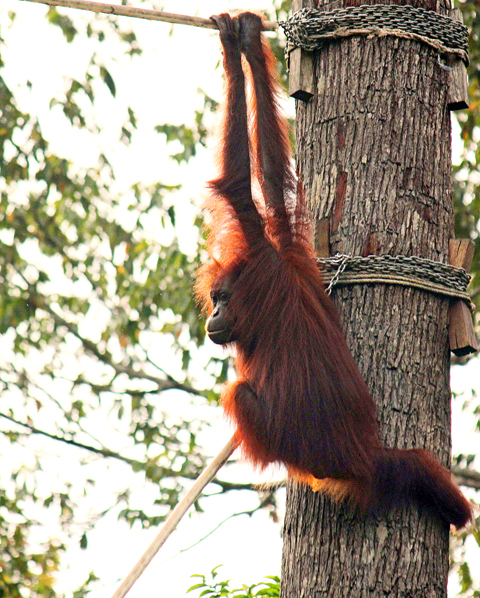Malaysian wildlife activists said yesterday they have photographic evidence of the endangered orangutan using man-made treetop bridges to find new mates and prevent inbreeding.
Orangutan habitats in Malaysia and Indonesia have been devastated as jungles are cleared by logging companies to make way for plantations, putting the ape at risk of inbreeding as they are split into smaller populations.
Since 2003 activists in Malaysia’s eastern Sabah State on Borneo island began building bridges in a bid to save the species, which could be virtually eliminated from the wild within two decades if deforestation continues.

PHOTO: AFP
“Over the years we have received numerous local eyewitness reports of the orangutans using these rope bridges, but this is the first time we have received photographic evidence,” Isabelle Lackman from environmental group Hutan said.
She said a series of pictures captured by a local in February showed a young male ape crossing a 20m single rope bridge, one of six built by the activists, in the Lower Kinabatangan Sanctuary in Sabah.
Experts say there are about 50,000 to 60,000 orangutans — Asia’s only great ape — left in the wild, 80 percent of them in Indonesia and the rest in Malaysian’s eastern states of Sabah and Sarawak on Borneo.
Hutan said the evidence marked a success in efforts to conserve the population, but called for the establishment of wildlife corridors that would enable the apes to move across the fragmented landscape and alongside rivers.
The group said using rope bridges is a “quick fix,” while Sabah wildlife department head Laurentius Ambu said a permanent wildlife corridor would help save other species, such as Bornean Pygmy Elephants, sunbears and clouded leopards.
“Even though it will be an expensive and long process, reconnecting isolated populations which were originally linked together will ensure the long term survival of not only Sabah’s orangutans, but other unique species,” he said.

Seven people sustained mostly minor injuries in an airplane fire in South Korea, authorities said yesterday, with local media suggesting the blaze might have been caused by a portable battery stored in the overhead bin. The Air Busan plane, an Airbus A321, was set to fly to Hong Kong from Gimhae International Airport in southeastern Busan, but caught fire in the rear section on Tuesday night, the South Korean Ministry of Land, Infrastructure and Transport said. A total of 169 passengers and seven flight attendants and staff were evacuated down inflatable slides, it said. Authorities initially reported three injuries, but revised the number

‘BALD-FACED LIE’: The woman is accused of administering non-prescribed drugs to the one-year-old and filmed the toddler’s distress to solicit donations online A social media influencer accused of filming the torture of her baby to gain money allegedly manufactured symptoms causing the toddler to have brain surgery, a magistrate has heard. The 34-year-old Queensland woman is charged with torturing an infant and posting videos of the little girl online to build a social media following and solicit donations. A decision on her bail application in a Brisbane court was yesterday postponed after the magistrate opted to take more time before making a decision in an effort “not to be overwhelmed” by the nature of allegations “so offensive to right-thinking people.” The Sunshine Coast woman —

BORDER SERVICES: With the US-funded International Rescue Committee telling clinics to shut by tomorrow, Burmese refugees face sudden discharge from Thai hospitals Healthcare centers serving tens of thousands of refugees on the Thai-Myanmar border have been ordered shut after US President Donald Trump froze most foreign aid last week, forcing Thai officials to transport the sickest patients to other facilities. The International Rescue Committee (IRC), which funds the clinics with US support, told the facilities to shut by tomorrow, a local official and two camp committee members said. The IRC did not respond to a request for comment. Trump last week paused development assistance from the US Agency for International Development for 90 days to assess compatibility with his “America First” policy. The freeze has thrown

PINEAPPLE DEBATE: While the owners of the pizzeria dislike pineapple on pizza, a survey last year showed that over 50% of Britons either love or like the topping A trendy pizzeria in the English city of Norwich has declared war on pineapples, charging an eye-watering £100 (US$124) for a Hawaiian in a bid to put customers off the disputed topping. Lupa Pizza recently added pizza topped with ham and pineapple to its account on a food delivery app, writing in the description: “Yeah, for £100 you can have it. Order the champagne too! Go on, you monster!” “[We] vehemently dislike pineapple on pizza,” Lupa co-owner Francis Wolf said. “We feel like it doesn’t suit pizza at all,” he said. The other co-owner, head chef Quin Jianoran, said they kept tinned pineapple